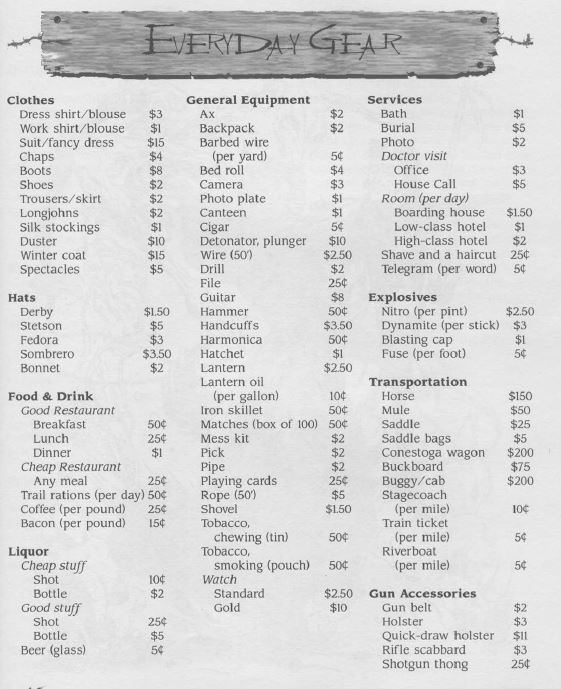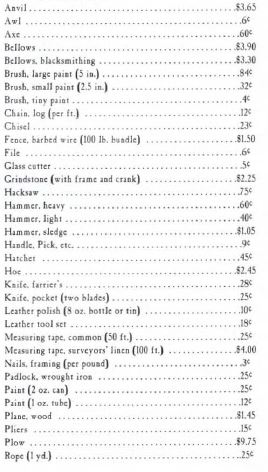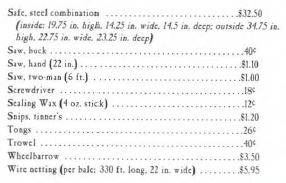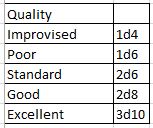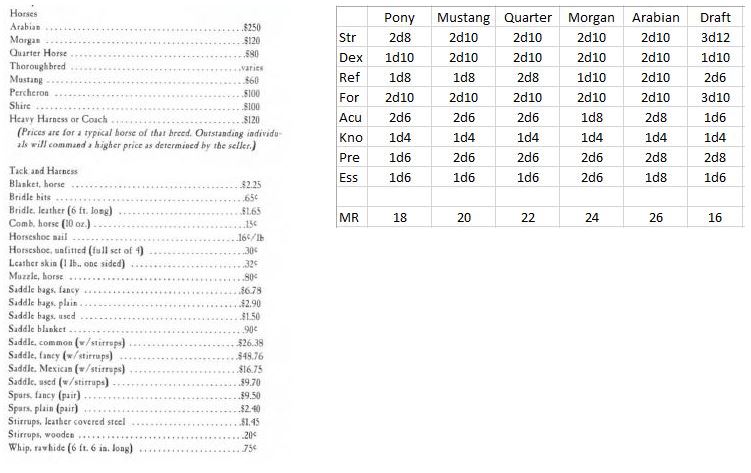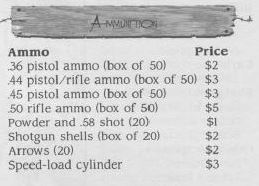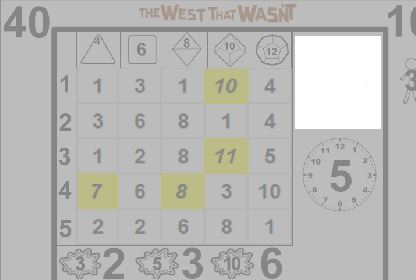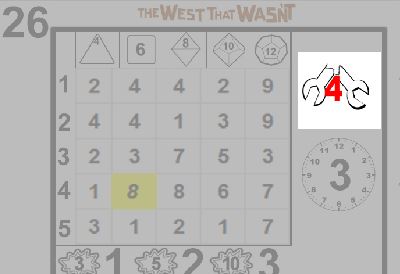The West That Wasnt - Gear
The following items are available in the West That Wasnt. These lists are not meant to be exhaustive, and have obviously been stolen from other sources just so we can get the playtesting underway. When this gets into a final state a new gear section will be created.
Contents
[hide]Using Gear
In most cases, to use an item it must be ready. Items are readied by performing an action. Readying an item might include taking a hammer from a toolbox, drawing a sidearm or even un-tethering a horse. Readying the item does not include any movement it takes to get to the item, but it does include any assembly if the item is normally stowed or carried unassembled. Readying an item costs between 1 and 4 APs depending on the size of the item.
Type Attributes
All items have an attribute that is related to the type of thing it is, such as a hammer is a tool, and therefore it has the tool attribute. These attributes are not all listed on the gear tables. Usually it is clear if a type attribute applies to a given item, but when it is not, the Judge has the final say.
Gear Lists
The following gear price lists have been cribbed from other sources (some might say stolen). This is temporary. For now, the authors efforts are concentrated on game mechanics over setting elements like economy. Once we have everything else how we like it, we will spend some time developing our own lists.
In case you do not recognize them, the gear lists come from Deadlands 1st edition and Aces & Eights. Hey, at least we are attributing the sources!
Everyday Gear
Tools
Tool Quality
Equipment is rated in quality from improvised to excellent. Improvised gear is equipment that has been made haphazardly or is being used in a way that it is not intended. For example, a rock or a stick may be used as a hammer, or even a shovel. They will work in a pinch, but are not good at the job. Poor quality tools are either old and worn out, or just shoddily made. The majority of tools are standard quality. Some items are of good quality, in general these cost 2-4x the listed price and are not available everywhere. The best items available are excellent quality, those produced by the finest craftsmen. They cost 10x the listed price.
Not all tools have the higher quality versions available. The simplest tools, such as hammers and shovels, can only be so good. Even the best versions do not produce better results, but instead are sturdier and last longer. Consult the Judge on whether a particular tool has higher quality options, and if they do, whether those items offer the increased efficacy, or only greater durability.
Mounts
Weapon Accessories
A speed load cylinder holds six rounds and can swap out quickly. Removing the old cylinder is 2 AP, replacing the new one is 1 AP. Reloading the cylinder is 1 AP for each round (as a normal reload).
Hand Weapons
What follows are the most common melee weapons available in the west. Most are also tools of some sort as well.
DMG: This is the full damage of the weapon, dealt versus unarmored/unprotected foes or on a P result.
RD: This is the reduced damage, dealt on an A result versus armored or protected foes.
Rel: This is the reliability of the weapon.
AP: This is the number of Action Points it takes to use the weapon. This number is added to the AP for the hand to hand attack type chosen.
S: This is the size of the weapon. This number is also the TN to fast draw the weapon.
Ad: This is the advantage factor of the weapon. All weapons have an advantage factor one higher versus unarmed foes.
Attributes: These are the additional attributes the weapon possesses. Attributes are explained in detail below.
Attributes
Deadly Deadly weapons deal one wound per multiple of the victims size.
Impact: Impact attacks deal the first wound in each attack at double the victims size, subsequent wounds at the victims size. Their damage is added directly to the Strength damage of the character.
Throw: Weapon can be thrown. See muscle powered section under ranged weapons for statistics.
Pain: Concussion damage is doubled when determining result from Stun Save.
Fast: Weapons with the fast attribute win initiative based ties versus other weapons.
Fistload: Character counts as armed versus unarmed foes or others using fistloads, unarmed versus others. Weapon deals Strength damage as well as weapon damage.
Impact Versus Deadly Damage
In TWTW there are two types of damage: Impact and deadly. Impact damage is dealt by blunt weapons and bare hands, while deadly damage is dealt by most other weapons, including edged and firearms. Each damage type is dealt differently in terms of attack damage as well as how the first wound is applied.
Impact Damage
Most brawling damage is impact, including clubs and improvised weapons that are not sharp, like broken bottles. When dealing impact damage, begin with the damage for the attack type (quick, standard or heavy), then add the DB of the character and the weapon damage. Compare this number to the targets size times two. If the result is less, deal that amount as concussion to the target. If the result is greater, deal one wound and subtract double the targets size from the result. Repeat the previous steps, but do not double the targets size.
Hank Daggett engages in fisticuffs with one of the Perkins brothers. In the first round, he chooses a heavy attack and hits for full damage of 14. Clem Perkins has a size of 6, so he deals one wound and 2 concussion. Looks like that heavy shot to the bread basket broke a rib or two. Had his blow result been 18 or more he would have dealt two wounds.
Because of the doubling of the initial wound, impact damage is much more likely to lead to high concussion damage, and very unlikely to lead to multiple wounds. This is consistent with most unarmed fights or blows with clubs. These results can still be deadly. See the Conflict for more on dealing impact wounds and wound effects.
Deadly Damage
Weapons without the Impact attribute are deadly. Deadly weapons deal one wound per multiple of the targets size. Any excess result after dealing all possible wounds is dealt as concussion.
While Hank dispatches Clem, Dave Perkins engages Cyril with his knife. Unlike Hank, Cyril is not adept at brawling. Dave slashes Cyril for 9, dealing one wound and 3 concussion. Had he dealt 12 or more he would have done two wounds.
Deadly damage is exactly like it sounds: more likely to kill.
Ranged Weapons
All ranged weapons have an Aim value, which is the AP cost of the aim action, followed by a slash with a penalty listed for snap fire. The SPD value is the AP cost of the weapon (when cocked or ready, as applicable) followed by the AP cost of any cock action. Cock actions ready one barrel, if more than one barrel exists, additional cock actions are required.
Ranged Weapon Attributes
Ranged weapons come in numerous sizes and shapes, often with differing performance based on the attributes of the weapon. What follows are three types of attributes: shot, action and other. Shot attributes discuss how projectiles are delivered, propelled and contained. Action describes how the weapon is operated mechanically. Other attributes discuss anything else about the weapon that is noteworthy in game play.
Shot Attributes
Cartridge: Cartridges are self contained bullet and powder in a single unit. Loading most cartridge weapons is a 1 AP action for each cartridge and speed loading is possible. Single action pistols cost 2 AP to start reloading unless they have the Top Break attribute. Some cartridge rifles also have longer reload speeds, and are notated in the attributes.
Muzzle Loader: Muzzle loading weapons require loose powder, ball and percussion cap. Muzzle loading a shotgun is a 10 AP action. If the weapon has multiple barrels, an attempt may be made to load both simultaneously. This requires a coordination check at TN 7. Success indicates both are loaded, failure indicates neither are loaded, but both will be successfully loaded next round with no check required. On a CF result, neither barrel is loaded and at least one required item is lost (one shot is spent). Performing a muzzle load on a rifle or musket requires 20 AP to complete. Muzzle loading weapons require 1 AP to cock, which can be performed simultaneously with the loading if desired. Muzzle loading weapons cannot be speed loaded.
Percussion: Cap and ball revolvers require a percussion cap, loose black powder and a lead bullet (ball) to load. Loading a Percussion handgun requires 7 AP. One cylinder can be loaded on a 3 TN coordination check, two cylinders on a 7. The chamber fails to load on a failure, but can be attempted again next round with no penalty. On a CF result, the chamber is not loaded and at least one required item is lost (the round is spent).
Action Attributes
Breech Load: Breech loading rifles and shotguns are 2 AP to fire when cocked, but require a 1 AP action to cock. Breech loading rifles can load a single cartridge for 1 AP, and can be speed loaded. Breech loading shotguns can load a single cartridge for 1 AP, and can be speed loaded.
Double Action: Double action revolvers are 1 AP actions to fire, and do not need to be cocked. A 1 AP action may be used to cock a double action revolver, if desired. Double action revolvers suffer a +1 to TN to all targets beyond close, if not cocked, because of the heavier trigger pull.
Fixed Cylinder: Fixed cylinder revolvers require 2 AP to begin a reload and 2 AP per round thereafter. They can be speed loaded.
Hammerless: Hammerless shotguns to not need to be cocked to fire.
Lever Action: Lever action rifles are 2 AP to fire when cocked. They require a 1 AP action to cock. Lever action rifles require a 2 AP to load the first round, but can load subsequent cartridges for 1 AP each. All but the first cartridge can be speed loaded.
Single Action: Single action revolvers are 1 AP when cocked, and require a 1 AP to cock. Single Action revolvers win initiative based ties versus other firearms.
Top Break: Top Break revolvers have a release latch that allows the barrel to draw down and eject spent cartridges, speeding reload time immensely. Top Break revolvers are 1 AP to reload each chamber, and can be speed loaded.
Trapdoor: Trapdoor rifles are similar to breech loading rifles, but instead of pushing the cartridge into the barrel from behind, it is dropped into the action from above. The trapdoor can be opened and reloaded for 2 AP, and cannot be speed loaded. They require 2 AP to cock.
Other Attributes
2x: Weapons with the 2x attribute may fire both barrels simultaneously. When firing both barrels, add the RD to the DMG on P results, and double the RD on A results.
Accurate: Accurate weapons receive the number in parentheses as a bonus to their shooting result if the shot follows an Aim action (not the initial aim to remove the penalty).
Fan Fire: A single action revolver is capable of fan firing. When using the fan fire action, the speed 1 AP per shot, and the Fan Firing rules apply.
Fistload: The character counts as armed versus unarmed characters or other characters using Fistloads. Otherwise, the character is unarmed.
Inaccurate: The short barrel of this weapon makes it harder to find a target. Aimed shots suffer a -1 penalty.
Long: Long weapons increase the TN of any fast draw attempt by the number in parentheses. Additionally, they suffer an initiative resolution penalty equal to the number in parentheses.
Muscle: Weapons with the muscle attribute cost 2 AP to use when ready/loaded, and load/ready for 2 AP. The character adds their DB to any damage done by the weapon.
Quick: Weapons with the quick attribute may reload/ready for 1 AP with a successful Speed Load check.
Scatter: Weapons with the scatter attribute always produce stray shots (see unintended targets, conflict section). Add one to the number of stray shots per range increment. Also, decrement the die type and penetration every two range increments. If a target is hit because of this rule, treat P results as A, and A results as D. Unarmored targets are treated as an A result.
Short: Weapons with the short attribute reduce the TN by 1 in any fast draw attempt.
Handguns
What follows are some of the most common handguns in use the the west. While this does not cover all of the possible makes and models, a comparable model to just about every common pistol is listed.
Legend
Ammo: The number of shots a fully loaded weapon carries.
Range: The number of paces per range increment.
Pen: Penetration value of the weapon.
DMG: Full damage value of the weapon. This is dealt to unarmored/unprotected foes or on P results.
RD: Reduced damage value. This is dealt to armored/protected foes on an A result.
Aim: This is the AP required to aim the weapon, followed by the penalty for snap shots.
SPD: The speed value of the weapon. The first number is the AP to fire the weapon, the number following the slash is the AP to cock it. A dash indicates cocking is optional (the weapon can be cocked for 1 AP).
Rel: The reliability of the weapon. This is compared to the malfunction number when applicable. See below.
Attributes: Any attributes the weapon possesses. See above for full descriptions of the attributes.
.44 Army
The 1860 Colt single action revolver is a very common weapon used throughout the civil war by both sides. It is a cap and ball revolver requiring each cylinder to be tamped down with an integrated lever ram. The reloading time of 6 AP assumes paper cartridges are being used. Increase time to 8 AP for loose powder.
The 1851 Colt single action revolver is the first generation of the 1860 model, using the same frame but with a smaller cylinder. The frame was smaller and lighter than other Colt revolvers available when it was introduced, such as the Walker. It is a cap and ball revolver requiring each cylinder to be tamped down with an integrated lever ram. The reloading time of 6 AP assumes paper cartridges are being used. Increase time to 8 AP for loose powder.
.41 Derringer
The Remington Model 95 is a small, muzzle loading over and under configuration pistol often carried concealed. The overall length of under 5 inches allows it to fit easily within a pocket or concealed in a closed fist. The small size allows all Fast Draw attempts to be made at TN 3, but also causes a -1 to all normal and aimed shots.
Walker Colt
The most powerful handgun in the west, the Walker Colt is big and relatively accurate as well as very deadly. Known for malfunction as much as for performance, the rarity still keeps the price quite high for a pistol.
Colt Single Action Army
The Colt single action army, often called "The Peacemaker" or "The gun that won the west", was the most popular firearm available after its release in 1873. It came in multiple versions, including the shorter barrelled gunslinger model and the original longer model for the US cavalry.
Colt Lightning
The 1877 Colt Lightning was the first double action Colt revolver. Like other double action revolvers, it can be cocked first and used like a single action. However, unlike later double action revolvers, it has the same loading mechanism of the single action army (the Peacemaker). It acts as a single action for reload purposes. The larger caliber version, the .41 listed here, is usually called the "Thunderer".
Smith & Wesson Schofield
The Schofield revolver was the first cartridge revolver adopted by the US Army. The Schofield is a reliable, single action, top break revolver. While not as common or inexpensive as the Peacemaker, the Schofield is an excellent weapon in its own right.
Smith & Wesson .44 Double Action
The S&W .44 double action was first available in 1881. It is a common double action revolver available in the west after that date.
Rifles
Rifles are probably the most common firearm in the west. Their utility for both hunting and self defense make them extremely valuable.
See the legend under handguns, above.
Winchester Model 1873
Coming in both rifle and carbine models, the Winchester model 1873 lever action was probably the most common firearm in the west with over 700,000 units produced. The combination of affordable price, high magazine capacity and good performance made it the weapon of choice for many a westerner.
Sharps Cavalry
The Sharps carbine was the most popular cavalry rifle of the civil war. Its short length made it easy to use while on horseback, and the falling block reload was easily converted to metallic cartridges.
Sharps Long Rifle
Renowned as the most accurate long range hunting rifle of the era, the Sharps long rifle was popular with sharpshooters and sportsmen alike.
Springfield Musket
After the civil war millions of muskets flooded the civilian market, making them extremely cheap and readily available. For single shot performance and price, the musket is a solid choice, but if you need more than one shot, look elsewhere.
Springfield Trapdoor
Many of the leftover muskets were converted to cartridge. One such variant is the trapdoor model which combines the economical viability of a musket with the practicality of a metallic cartridge.
Spencer Rifle
One of the earliest lever action rifles, the Spencer provided a 7 shot magazine which greatly increased firepower versus the musket.
Henry Rifle
The predecessor to the Winchester 1873, above, Henry rifles are common on the ranges and plateaus of the west.
Shotguns
All shotguns have the Long (1) attribute. They can be "sawed off" to either a normal length (no attribute) or Short.
Muscle Powered Weapons
Equipment Reliability
Every piece of equipment has a reliability (Rel) rating from 1-12, with lower numbers being more durable. The reliability section of the action card is above the clock face in the upper right hand portion of the card.
On most cards, that section is blank, like this one. This means that no action is necessary. All equipment performs as expected. Some cards, however, have a broken wrench with an associated number.
When this symbol appears, compare the reliability of the equipment to the number shown inside the broken wrench (in this case a 4). If the reliability of the equipment is higher than the number shown, the equipment fails. Check the toggle result, on a yes the equipment fails after completing the task, on a no it fails before.
If the equipment has a reliability of 1 an extra step must be taken. Immediately shuffle the entire deck, except this card, and cut. If the card cut shows the broken wrench with a 2, the equipment fails. Otherwise, it works properly.
Improvised Usage
All of the above assumes that the equipment is being used as designed. When being used in a rough or unintended way equipment is more likely to fail. For new equipment, add 1 to the rel. For old and/or otherwise abused equipment, add 4. In all other cases add 2. Strange or extremely hazardous usage may bring an extra penalty to the Rel of +1-3 at Judges discretion.
Hank wants to smack an angry cowboy with a shovel. The shovel is in average condition, so the Judge adds 2 to the Rel, bringing it to 3.
Some uses are anticipated if not intended, such as hitting an adversary with the butt of a rifle or the handle of a pistol. These uses add 1 to the Rel unless the weapon is old or decrepit, in which case 2 is added.
